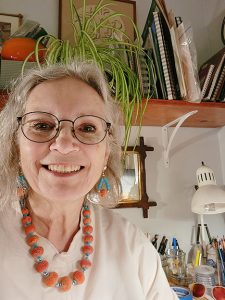Sue Beetle

Getting outside is important to me for my health and well-being, and a frequent source of subject matter.

Q&A with Sue Beetle
How would you describe your background?
I read artists’ books and magazines, have taken some in-person workshops, and Zoom classes on the laptop.
When did you know you wanted to be an artist?
What would surprise people to learn about you?
How would you describe your art to someone who has never seen it?
I find architectural shapes equally attractive but draw them using first pencil, then old style dip pen and ink.
Living things—animals, plants, leaves—I carve a woodblock and make prints using the white-line method, which completes each print in its entirety before another print is made from that block. These prints use watercolor paints. They are technically un-numbered monoprints.
My prints are simpler lines with few details compared to the other two mediums.
What achievements in the area of art are you proudest of?
As a “newbie” this is very encouraging!
How would you describe your art process?
I don’t need the tablet if its a woodcut. My color choices are simplified and mobile once the block is cut and ready to print. White-line woodcuts are an interesting blend of planning and spontanaity. And the drawing has to be transferred in reverse to print “proper.”
Working with Pen & Ink is the simplest, sketch onto paper and then ink it, or just go straight on with the ink.
What is your usual studio/working day like?
My studio time is erratic. I do try to spend at least some time making art daily, inserting it in depending on weather, necessary activities, appointments… Getting outside is important to me for my health and well-being, and a frequent source of subject matter. When time is limited, a pencil painting is much more available to work on — just color or shade an area, and leave it when needed. The print session requires more of a time commitment for set-up and clean-up. Both are very absorbing — once started, hard to stop..
Natural light is preferred but doesn’t always happen, especially in winter.
What is the most delightful part of your life outside of work?
Getting together with friends is always wonderful, I’m still in touch with some from grade school and high school!
